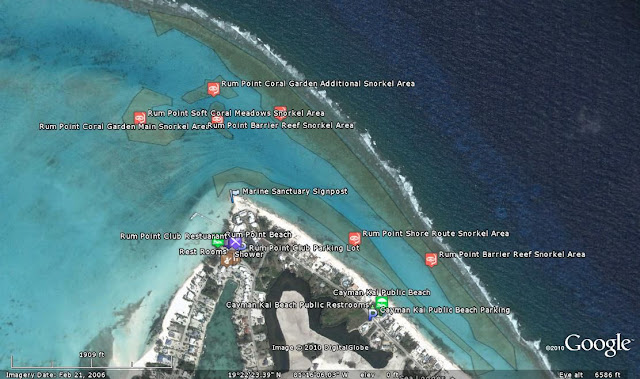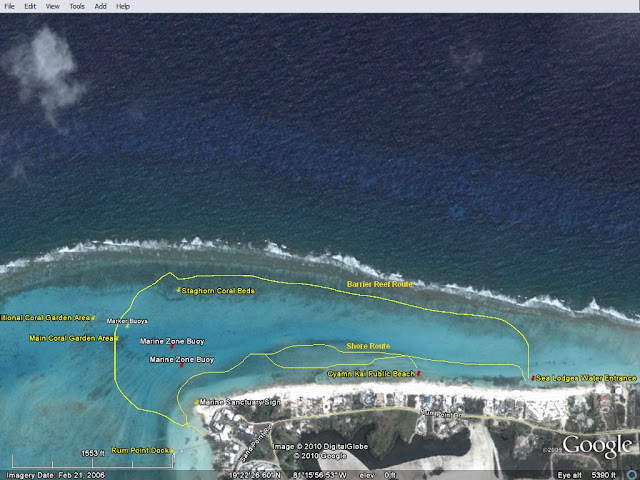Testudo's Snorkel Guides: The Rum Point Barrier Reef
Sprawling Staghorn Coral thicket, Rum Point Barrier Reef, Grand Cayman
Throughout my travels to the various isles and coastal regions of the Caribbean, there has remained one elusive and unfulfilled desire. While I have had the privilege to snorkel barrier reefs reached via boat, my true aim had always been to be able to swim out to one from shore, just like portrayed in the movie The Blue Lagoon (having Brooke Shields along for the swim would be nice too). I imagined that a great reward must await those who would venture out to where the fluid power of the ocean collided with the perceived permanency of the land. The Barrier Reef along the North Side and East End districts of Grand Cayman finally provided me with such an opportunity.
LOCATION INFO: The surface level reef creates a sinuous off-shore barrier, uninterrupted for long stretches, along most of the northern and eastern edges of the island. There are also strands located along West Bay, predominately off of Barkers National Park. The distance from shore varies from as close as 40 yds. at spots on the East End to around 400 yds. off the tip of Rum Point.
The route described below starts you at the reef area approximately 150 yds. out from shore. The typical current in the area usually runs east to west, so I will usually walk about a half-mile down the beach from Rum Point to the Sea Lodges complex for my entry. You can park your vehicle at the Rum Point Club (19°22'16.70"N 81°16'15.60"W) and walk the half-mile. This is a good idea since the beach area is a natural exit and endpoint to your snorkel, plus there are concessions and restrooms.
Another good parking spot, closer to the start of the route, is the Cayman Kai Public Beach parking lot (19°22'8.80"N 81°15'59.62"W)(1/10 mile west of the Sea Lodges). It has a simple restroom facility. It is easy to miss, so when coming from the east, look for the small sign and parking lot on the right-hand side, about 7 or 8 lots past the Sea Lodges.

Link to a larger interactive map of Rum Point
 (Click image for printable version)
(Click image for printable version)CONDITIONS: Look for a sandy spot to make your water entry and don your gear. The sea floor near shore can be rocky, with tufts of sea grass beginning about 5-10 yards out. The grassy meadows will last for about 25-30 yards and then quickly give way to a sandy bottom. The depth quickly jumps from 4-8 ft to 15-20 ft. On the snorkel out, be on the watch for passing Eagle Rays and Southern Rays or an occasional Barracuda wingman. With little else to see, this is a good place for a power snorkel. About 100 yds. out the sea floor will display a gradual incline as you approach the reef structure.
The best area to focus your explorations is the sweet spot, halfway between the sand zone and the actual barrier reef. Here you will find a profusion of fish, along with a plethora of soft corals, sea whips and rods. The average depth at ebb tide is 4-6 ft. The closer you approach the reef, the shallower the water becomes. The pictures below were taken during low tide, so you can see it is all but impossible to actually swim over-top the barrier reef. As you work westward, there are pockets of detritus and debris where the reef has been battered and yielded some ground to the constant force of the waves. The fish do not see many human visitors like some other areas, but for the most part do not seem to mind you intruding upon their routines.
Unlike the sections of the Barrier Reef many of the Sting Ray City tours visit, this segment does not feature much in the way of impressive coral structures. The reef is predominately composed of ancient coral bases and rubble with most living coral being located in the sweet spot described earlier.
WHAT YOU WILL SEE: Being at the point of water exchange from the open sea, the clarity is usually excellent; even when when conditions may be poor closer to shore. There tend to be more Angelfish, Trumpetfish and Black Durgons here than other spots around the Rum Point area. Noticeably absent are the larger fish such as Grouper, Snapper and Porgies. Lobsters and crabs abound, along with different Grunts, Butterfly and Squirrelfish. A little less than a third of the way towards Rum Point, a beautiful soft coral and sea fan garden will appear. With the water so shallow, a bright and sunny day creates a profusion of color that is truly breathtaking.
Look for Trumpetfish trying to pass themselves off as branches of coral and Triggerfish hiding nearby. The next portion of the journey will take you past lone Brain and Lobed Star coral sentries busily tended by their little denizens. You will then come upon an area of larger rocks and boulders with little coral or plant life. This is a good marker to begin looking toward the shore side for what I consider the highlight of snorkel, the beds of Staghorn Coral thickets. These are the most impressive sprawling thickets of Staghorn I have happened upon to date. The three or four large thickets in this area make for an impressive miniature forest. Floating above these coral canopies reveals many of the smaller endemic fish species like Gobbies, Wrasses and Blue Chromis.
If you veer away from the reef a bit by the Staghorn thickets, you will come upon a wondrous little section of reef known as Pete's Paradise. Here the Staghorn grows in pockets intermingled with Brain and Star corals and creates one of the most picturesque underwater sights. Lots of Squirrelfish and other smaller species. This is one of the few spots were the Black Durgon are a little less shy and avail themselves for pictures.
You now have a decision to make. If you have had enough for the day, you can head in towards the Rum Point Club and grab a mudslide, or continue on towards the outer portion of boulder coral garden that extends out to the reef. If you head in, there will not be much to see, except for remnants of Staghorn thickets from days of old and a pretty desolate sea floor. So another good time for a power snorkel. You can continue to follow the reef where there will be boulder corals spread over the area. The water is usually super clear here, but a bit deeper. So unless you free dive, I usually suggest you take the next option and hit the Boulder Coral Garden. If you choose to proceed to the Boulder Coral Garden, then follow along the reef until you reach the point of land in front of the Retreat Condominiums just past Pete's Paradise, now start heading back to shore making a line to the pier. You will soon come upon the large Lobed Star corals that comprise the bulk of the outer coral gardens coral field. Taking this option will give you the complete Rum Point snorkel experience.
(Click here for the Coral Garden Guide)
Black Durgon at the shallow crest of the reef Yellowtail Damselfish
Banded Butterfly fish Trumpetfish among the sea whips
Grunts and Blue Tang mass at a coral Lobster and Trunkfish face-off
Typical Seascape near the reef Porcupinefish hides under a ledge
Male Southern Ray on the prowl Shy Porcupinefish makes a get-away
Typical small coral clusters along the reef Sea Rods
Grunts school amongst the Staghorn Coral
A school of Blue Tang
A reef apex predator lurks in the distance
A feeding Sting Ray
A Flying Gurnard shows his colors
A reef scene
Perfection?
Morning has broken
School of Squirrelfish
A sampling of the varied fish species
Location of Pete's Paradise Staghorn Garden
So now that my desire has finally been realized, it is time to find another cinematically derived challenge...Jaws, the Deep, the Abyss??? While there are better areas to snorkel the reef, this section is particularly accessible and makes for a good introduction for a longer snorkel, a bit farther from shore. If you are extremely comfortable in the water, the backside of the reef awaits....
DOWNLOAD THE GUIDE FROM GOOGLE DOCUMENTS HERE:
VIEW ADDITIONAL PICTURES HERE:
© 2010 Testudo Enterises, LLC(Click here for the Boulder Garden Guide)

No comments:
Post a Comment